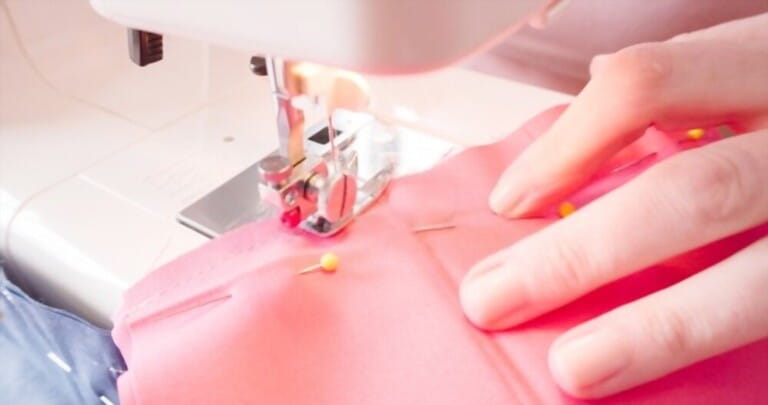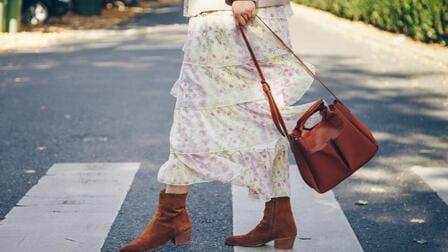Slimming Down a Bulky T-Shirt
You should take off your sleeves and turn your clothing inside out. Select a t-shirt that fits loosely and one that you would like to modify. Turn the shirt inside out and cut off the excess fabric from the sleeves, being careful to leave the original seam intact so that the sleeves can be reattached to the shirt body.
Cut the seams between the sleeves apart. First, you need to flatten the sleeves, and then you can cut the seam. Leave the cuffs off and the hem alone.
Choose a shirt that fits you nicely and layer it over the baggy one. First, you should invert the smaller shirt and fold the sleeves inward so they don't get in the way. Make sure the collars and shoulders of the smaller shirt are aligned with those of the larger shirt.
Make sure the front of both shirts is showing.
You can also use a sleeveless shirt or a fitted t-shirt for this.
Draw the smaller shirt to scale, making sure to account for seam allowances. Make a pattern by tracing the armholes and sides of the smaller shirt, being sure to include an extra half an inch (1.27 centimeters) for the seam.
Use a dressmaker's pen (for lighter colors) or chalk (for darker colors) for the best results. If you don't have either, a washable marker will do in a pinch.
Trace 1 inch (2.54 cm) below the shorter shirt if the bigger one is too long.
Pin the larger shirt together so it doesn't move when you cut it. Take off the smaller top and pin the larger one inside the marked areas. Use a pair of fabric shears to cut the garment following the drawn line. When you're done cutting, take out the pins but keep them handy; you'll need them again later.
Pins are used to keep the fabric in place while it is being cut.
Pin and stitch the sleeves to the shirt. With the right sides of the shirt facing in, spread it out and pin the sleeves to the shoulders. Sew the sleeves to the shoulders with a stretch stitch, a seam allowance of half an inch (1.27 centimeters), and thread that matches the rest of the garment. As you sew, take out the pins.
Backstitching at the beginning and end of a seam will reinforce it.
Reduce the width of the sleeves if they do not fit the garment.
Complete the garment by stitching the shoulder and side seams. Spread the shirt out flat and make sure the shoulder and side seams are lined up. Use a stretch stitch and a seam allowance of half an inch (1.27 centimeters) when sewing. You should begin at the sleeve hem and work your way down to the bottom of the shirt.
Always do a backstitch before and after a seam.
Use pins to keep the shirt together before you start stitching, then take them out.
Trim the cuffs and hem if necessary. If the shirt's sleeves or hem are too long when you try it on, make a notation at the length you prefer before removing it. To the marked point, fold the sleeve or bottom of the garment. Use a stretch stitch and a seam allowance of half an inch (1.27 centimeters). If necessary, snip off the excess hem as near to the stitching as you can.
Backstitching at the beginning and conclusion of a sewing project is a must.
Adding a second line of stitching right below the first gives the garment a more genuine look.
To make the backstitching less obvious, start and stop stitching at a seam instead than in the middle of the hem.
Turn the shirt inside out, and snip off any loose threads. Following these instructions, you will have a whole new, personalized shirt. Since the fabric will not fray, serging the inside seams of the garment is unnecessary. The seams, however, can be reduced in size.
Taking off a Squeaky T-Shirt
Pick a shirt you want to customize. This method works within reasonable parameters only for form-fitting shirts. The shoulders of the garment should still be a good fit. A little shirt can be made to fit a larger person, but only up to a certain point.
Cut along the seams after turning the shirt inside out. Start at the bottom hem and work your way up to the sleeves when cutting the shirt flat. The sleeves should also have their side hems cut, but the sleeves should otherwise be left attached to the shirt.
The side panels need a suitable fabric, so go hunting. This fabric is for closing the seams under the sleeves and along the sides of the garment. Use jersey fabric that is a close match, ideally taken from a similar shirt; if this is not possible, acquire some from a fabric store.
No matching hues to be found? Go with a hue that stands out! If the shirt has a printed design, try to match your accessories to the colors used.
Fabric can be used to fill up spaces by being cut into slanted rectangles. Take a measurement from the end of the sleeve, through the armhole, and all the way down to the hem of the shirt. Use these measurements to cut two rectangles, the bottom one measuring 6 inches (15.24 centimeters) wide and the top one measuring 5 inches (12.7 centimeters) wide.
Make the hem at the bottom of the shirt about 6 inches (15.24 centimeters) wide if you're using fabric from another shirt. Hem allowances require an additional inch (or 2.54 cm).
To account for hems on purchased cloth, add two inches (5.08 centimeters) to the total length.
Modify the spacing between each panel to suit your needs.
Pin the panels onto the shirt. To begin, turn the panels and the shirt inside out. Secure the cut edges of the sleeves and the left sides of the front and back of the garment to the first panel with pins. You should do the same thing with the right side and the next panel.
If you're using panels from a different garment, make sure the hems are even.
If you're using prefabricated panels, check to see that they extend uniformly past the cuffs and hem.
You should sew the panels onto the shirt. Start stitching at the hem and stop at the sleeve edge. Make sure you use a stretch stitch with thread that matches the fabric color and a 1/2-inch (1.27-centimeter) seam allowance. While stitching, take out the pins.
Backstitching at the beginning and conclusion of your stitching will help reinforce the seams.
Wrap the ends of the panels. Fold down the top and bottom edges of each panel until they meet the hems of the shirt and sleeves. Pin them in place, then continue stitching. It usually takes two rows of sewing to adjust seam allowances so that they match the current hems. Take out the pins and trim the excess fabric close to the seam.
At the beginning and the end of each seam, backstitch.
If you're using fabric from an old shirt, you'll only need to hem the sleeves.
Turn the shirt inside out and finish up any remaining details. Look over the shirt and snip out any stray threads. Remove the shirt collar if desired. The collar can be hemmed or left unfinished, according on your preference.
The internal seams don't need to be finished, but can be trimmed for a more tailored look.
Adjusting the neckline from a crew to a V
You can take apart the collar's front with a seam ripper. The collar need only be taken off in the front of the shirt. Stop when you go to the shoulder area and don't touch the collar in the back.
Separate the collar down the middle. Find the exact middle of the collar and make your incision there. Two parallel strips will appear on the shirt's sides.
Cut the front of the shirt into a V. Use the strips from the first collar to establish a suitable V depth. You can stretch the strips out a little bit, but too much will ruin them. You need to start the V at the left collar edge and finish it at the right.
First, fasten the left side of the collar. Make sure the rough edge is facing up and the folded edge is facing down when you pin the collar. The collar will be turned up to cover the seam in the future.
A quarter to half an inch (0.64 to 1.27 centimeters) of extra length should be added to the collar so that it reaches the right collar side.
Fold the end of the collar so that it meets the bottom of the V. Depending on the length of the extension, this might be anywhere from 0.64 to 1.27 cm (0.15 to 3.5 inches). If you need to, you can secure the fold with a pin.
A neat front seam can be created by folding over the collar's tail.
Sew the collar to the neck opening. Sew from the shoulder down to the bottom of the V; make any necessary alterations to the folded end before continuing. Make sure to use a stretchy stitch and a seam allowance of at least 1/4 inch (0.64 centimeters).
Backstitching at the beginning and end of your stitching will give it more durability.
While stitching, take out the pins.
Put together and stitch the correct collar side. Right side of collar should overlap left side and be pinned. Stitch it with a stretch stitch, a seam allowance of 14 inch (0.64 centimeters), and thread in a color that matches the fabric. When you're done, take out the pins.
This side does not require the collar to be folded over.
When beginning and ending a sewing project, backstitch.
Hand-stitch the loose end of the right collar down. For this, you'll need a needle and some matching thread. When stitching the right collar, go through both layers, but just the one on the left. This guarantees that the seams are concealed from view.

Modifying Appearances Differently
Make it so the top has a scoop neck. Make a pattern by tracing the front of the collar and extending the lines out 2 inches (5.08 centimeters) at the sides and 1 inch (2.54 centimeters) at the bottom. When you flip the garment over, measure the collar from the back and add an additional inch (2.54 centimeters). Follow the lines you drew when cutting.
You can leave the edges unfinished if you choose, or you can hem them to make them look neater.
Create a shirt that can be tied at the side. Take a t-shirt and cut it open along the sides, from the bottom up to the armpits. Make notches in the sides of the shirt that are 2 inches (5.08 centimeters) wide and 1 to 2 inches (2.54 to 5.08 centimeters) apart. Stretch the tassels by pulling on them, and then double-knot the front tassels to their back counterparts.
Create perfectly even notches by slicing through the shirt's front and back at the same time.
You may make it into a scoop neck by taking off the collar.
Use lace to extend the length of a tank top. Cut a length of lace that is 4 inches (10.16 centimeters) longer than what you need to wrap around the bottom of your shirt. The lace should be inserted into the shirt at the half-inch (1.27-centimeter) mark. Overlap the side edges by 1 inch (2.54 centimeters) and sew one piece to the front hem and the other to the rear hem. Attach the lace by stitching along the existing seams of the shirt.
Backstitching the beginning and ending of a sewing project adds reinforcement.
Use gathered lace, or gather it yourself, for a more feminine look.
Use the same method, except for each sleeve you will only need one lace piece.
If you want to make a statement, tie-dye a shirt. The shirt should first be washed, but not dried. Wrap it up and use rubber bands to keep it together. Make a batch of fabric dye and use a plastic squeeze bottle to apply it to the garment. Put the garment in a plastic bag with a zipper and leave it for a while. First, use cold water to rinse, then take off the ties and wash in warm water.
Instead of rolling the shirt up and securing it with rubber bands, try dip-dying it for an ombre effect.
Use fabric paint and a stencil to decorate a shirt. Stuff some cardboard into the garment. Tape it down if you need to, then set a stencil on top. Start with the outer edges of the stencil and work your way inward using a sponge brush and fabric paint. Once the paint has dried, you can take off the stencil.
Use fabric spray paint for a more up-to-date look.
Use bleach spray to create a one-of-a-kind pattern.
Make stencils for your projects using freezer paper.
Explore the world of iron-on decals. To make an iron-on transfer, you may either buy a premade design or use a printer and blank iron-on transfer paper to make your own. Remove the backing, place the design face down on the shirt, and iron as directed. After removing the transfer paper, the shirt is finished.
Remember to invert your own design before printing it!
To avoid the print from flaking off, follow the instructions on the iron-on packet carefully and wash the shirt first.
Holding and pressing the iron hard will ensure that the iron-on transfer stays hot.












